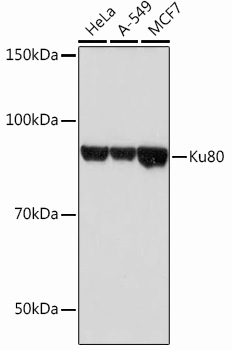Epigenetics & Nuclear Signaling Antibodies 5
Anti-Ku80 Antibody (CAB12338)
- SKU:
- CAB12338
- Product Type:
- Antibody
- Reactivity:
- Human
- Host Species:
- Rabbit
- Isotype:
- IgG
- Antibody Type:
- Monoclonal Antibody
- Research Area:
- Epigenetics and Nuclear Signaling
Description
| Antibody Name: | Anti-Ku80 Antibody |
| Antibody SKU: | CAB12338 |
| Antibody Size: | 20uL, 50uL, 100uL |
| Application: | WB IHC IF |
| Reactivity: | Human |
| Host Species: | Rabbit |
| Immunogen: | A synthesized peptide derived from human Ku80 |
| Application: | WB IHC IF |
| Recommended Dilution: | WB 1:500 - 1:2000 IHC 1:50 - 1:200 IF 1:50 - 1:200 |
| Reactivity: | Human |
| Positive Samples: | HeLa, A-549, MCF7 |
| Immunogen: | A synthesized peptide derived from human Ku80 |
| Purification Method: | Affinity purification |
| Storage Buffer: | Store at -20°C. Avoid freeze / thaw cycles. Buffer: PBS with 0.02% sodium azide, 0.05% BSA, 50% glycerol, pH7.3. |
| Isotype: | IgG |
| Sequence: | Email for sequence |
| Gene ID: | 7520 |
| Uniprot: | P13010 |
| Cellular Location: | |
| Calculated MW: | 83kDa |
| Observed MW: | 86KDa |
| Synonyms: | KARP-1, KARP1, KU80, KUB2, Ku86, NFIV |
| Background: | The protein encoded by this gene is the 80-kilodalton subunit of the Ku heterodimer protein which is also known as ATP-dependant DNA helicase II or DNA repair protein XRCC5. Ku is the DNA-binding component of the DNA-dependent protein kinase, and it functions together with the DNA ligase IV-XRCC4 complex in the repair of DNA double-strand break by non-homologous end joining and the completion of V(D)J recombination events. This gene functionally complements Chinese hamster xrs-6, a mutant defective in DNA double-strand break repair and in ability to undergo V(D)J recombination. A rare microsatellite polymorphism in this gene is associated with cancer in patients of varying radiosensitivity. [provided by RefSeq, Jul 2008] |
| UniProt Protein Function: | Ku80: the 80-kilodalton subunit of the Ku complex, also known as ATP-dependant DNA helicase II. A single stranded DNA-dependent ATP-dependent helicase. It functions together with the DNA ligase IV-XRCC4 complex in the repair of DNA double-strand break by non-homologous end joining and the completion of V(D)J recombination events. This gene functionally complements Chinese hamster xrs-6, a mutant defective in DNA double-strand break repair and in ability to undergo V(D)J recombination. A rare microsatellite polymorphism in this gene is associated with cancer in patients of varying radiosensitivity. Has a role in chromosome translocation. The DNA helicase II complex binds preferentially to fork-like ends of double-stranded DNA in a cell cycle-dependent manner. It works in the 3'-5' direction. Binding to DNA may be mediated by p70. |
| UniProt Protein Details: | Protein type:Nucleolus; RNA-binding; DNA-binding; EC 3.6.1.-; Nuclear receptor co-regulator; Helicase; EC 3.6.4.- Chromosomal Location of Human Ortholog: 2q35 Cellular Component: cytosol; membrane; nuclear chromosome, telomeric region; nuclear telomere cap complex; nucleolus; nucleoplasm; nucleus; plasma membrane Molecular Function:5'-deoxyribose-5-phosphate lyase activity; ATP binding; ATP-dependent DNA helicase activity; damaged DNA binding; DNA binding; double-stranded DNA binding; double-stranded telomeric DNA binding; protein binding; protein C-terminus binding; telomeric DNA binding; ubiquitin protein ligase binding Biological Process: cell proliferation; DNA duplex unwinding; DNA recombination; DNA repair; double-strand break repair; double-strand break repair via nonhomologous end joining; innate immune response; negative regulation of transcription, DNA-dependent; positive regulation of interferon type I production; positive regulation of neurogenesis; regulation of smooth muscle cell proliferation; telomere maintenance; transcription, DNA-dependent; viral reproduction |
| NCBI Summary: | The protein encoded by this gene is the 80-kilodalton subunit of the Ku heterodimer protein which is also known as ATP-dependant DNA helicase II or DNA repair protein XRCC5. Ku is the DNA-binding component of the DNA-dependent protein kinase, and it functions together with the DNA ligase IV-XRCC4 complex in the repair of DNA double-strand break by non-homologous end joining and the completion of V(D)J recombination events. This gene functionally complements Chinese hamster xrs-6, a mutant defective in DNA double-strand break repair and in ability to undergo V(D)J recombination. A rare microsatellite polymorphism in this gene is associated with cancer in patients of varying radiosensitivity. [provided by RefSeq, Jul 2008] |
| UniProt Code: | P13010 |
| NCBI GenInfo Identifier: | 125731 |
| NCBI Gene ID: | 7520 |
| NCBI Accession: | P13010.3 |
| UniProt Secondary Accession: | P13010,Q0Z7V0, Q4VBQ5, Q53HH7, Q7M4N0, Q9UCQ0, Q9UCQ1 A8K3X5, |
| UniProt Related Accession: | P13010 |
| Molecular Weight: | 82,705 Da |
| NCBI Full Name: | X-ray repair cross-complementing protein 5 |
| NCBI Synonym Full Names: | X-ray repair complementing defective repair in Chinese hamster cells 5 |
| NCBI Official Symbol: | XRCC5 |
| NCBI Official Synonym Symbols: | KU80; KUB2; Ku86; NFIV; KARP1; KARP-1 |
| NCBI Protein Information: | X-ray repair cross-complementing protein 5 |
| UniProt Protein Name: | X-ray repair cross-complementing protein 5 |
| UniProt Synonym Protein Names: | 86 kDa subunit of Ku antigen; ATP-dependent DNA helicase 2 subunit 2; ATP-dependent DNA helicase II 80 kDa subunit; CTC box-binding factor 85 kDa subunit; CTC85; CTCBF; DNA repair protein XRCC5; Ku80; Ku86; Lupus Ku autoantigen protein p86; Nuclear factor IV; Thyroid-lupus autoantigen; TLAA; X-ray repair complementing defective repair in Chinese hamster cells 5 (double-strand-break rejoining) |
| UniProt Gene Name: | XRCC5 |
| UniProt Entry Name: | XRCC5_HUMAN |







